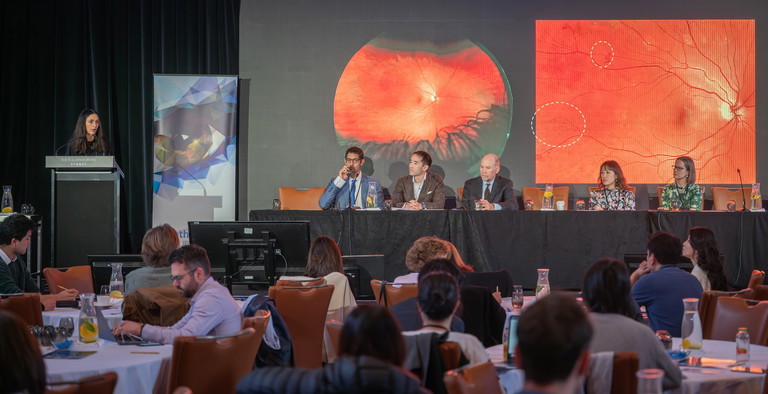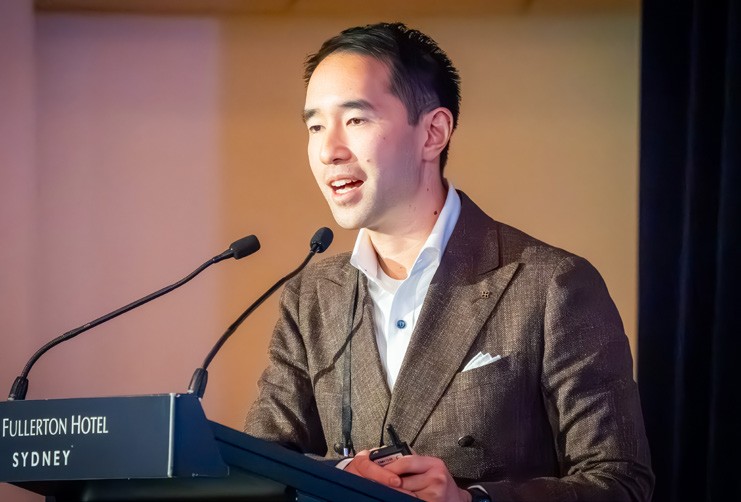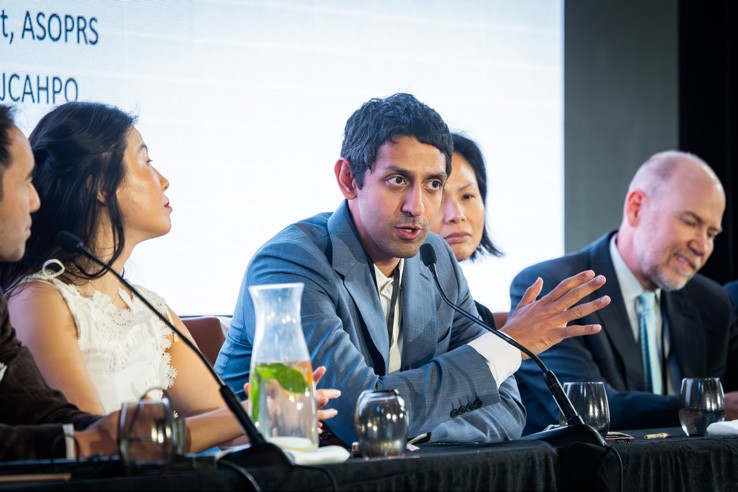mievent
Advancing Clinical Excellence
Ophthalmology Updates! 2025
WRITER Melanie Kell

Pregnancy in ophthalmology symposium: From left Drs Amy Cohn (Melbourne), Jay Sridhar (USA), Adrian Fung (Sydney), Richard Allen (USA), Jennifer Fan Gaskin (Melbourne), Jo Sims (New Zealand).
The ninth Ophthalmology Updates! conference in Sydney brought together leading eye health professionals from Australia and around the world, for a comprehensive examination of contemporary advances across multiple subspecialties. Convened by Professor Adrian Fung, the event successfully balanced practical clinical updates with broader professional development themes.
OCULOPLASTIC EDUCATION AND THYROID EYE
Speaking at his first Australian conference, Associate Professor Richard Allen, an oculoplastics specialist from Baylor College of Medicine in Houston, in the United States, kicked off the sessions with presentations on surgical education and thyroid eye disease protocols. Assoc Prof Allen outlined his decade-long commitment to creating freely accessible surgical videos, addressing geographical barriers through unrestricted online access to more than 400 edited, narrated videos covering eyelid, lacrimal, and orbital surgery. The topic of education was explored further with a panel discussion at the conclusion of the conference.
Thyroid Eye Disease Management
Turning his attention to the management of thyroid eye disease, Assoc Prof Allen stressed the need for smoking cessation, for diabetes to be controlled, and to manage sleep apnoea. He recommended thyroid control using intravenous steroids over oral alternatives, in line with the European group on Graves’ orbitopathy (EUGOGO) protocol’s superior efficacy profile. He discussed emerging biologic therapies, particularly teprotumumab’s positive results, while acknowledging concerns about durability; side effects including hearing loss; and significant costs approaching US$350,000 per treatment course.
The key takeaways from this presentation were that biologics are most appropriate for moderate-to-severe active disease rather than mild or chronic presentations. Careful patient selection is essential for optimal outcomes.
ASTIGMATISM AND IOL TECHNOLOGIES
Dr Ben LaHood, a cataract and refractive surgeon from South Australia, provided evidence-based guidance on astigmatism management, reminding delegates that residual astigmatism significantly impacts visual outcomes. Studies demonstrate reduced odds of achieving 6/6 visual acuity once residual astigmatism exceeds 0.75 dioptres.
His clinical pearls for biometry included:
• Avoid applying artificial tears immediately before measurement, particularly in dry eyes,
• Use predicted posterior corneal measurements rather than direct measurement,
• Use the intraocular lens (IOL) formula when calculating the lens and its positioning on eye.
Moving on to extended depth of focus IOLs, Dr LaHood highlighted the Johnson and Johnson Tecnis PureSee lens, which uses “continuous refractive power change” technology, reporting 96% of patients achieving within 0.5 dioptres of target refraction with good tolerance for residual astigmatism.
For irregular corneas, he advocated the IC-8 pinhole lens (Bausch Surgical) as a therapeutic rather than presbyopic solution, emphasising realistic patient counselling regarding potential multi-step procedures and noting approximately 10% explantation rates.
RETINAL DISEASE MANAGEMENT
Retina specialist, Associate Professor Jay Sridhar from the Olive View-University of California, Los Angeles Medical Center, presented comprehensive overviews of diabetic macular oedema (DMO) management and emerging photobiomodulation therapy.
He said anti-VEGF agents remain the gold standard for DMO in the United States, with bevacizumab widely used off-label compared to branded alternatives. Diabetic Retinopathy Clinical Research Network (DRCR) trials revealed that while Protocol T demonstrated early superiority of aflibercept, these differences disappeared by two years, with no agents showing superiority at five years.1
Crucially, Protocol U highlighted that one-third of patients deemed “non-responsive” to anti-VEGF therapy improved with three additional monthly injections, suggesting many patients require more intensive early treatment rather than switching agents.2
Speaking on photobiomodulation for dry age-related macular degeneration, Assoc Prof Sridhar explained that the Valeda system, which was recently authorised by the United States Food and Drug Administration (US FDA), uses specific wavelengths (600–1100 nm) targeting mitochondrial cytochrome C oxidase. The LIGHTSITE III trial demonstrated meaningful benefits in 148 eyes over 24 months, with patients gaining an average 5.4 letters compared to sham treatment and significantly lower geographic atrophy development (6.8% versus 24% in controls).3
TRAUMA SURGERY AND PVR MANAGEMENT
Assoc Prof Sridhar’s trauma surgery presentation stressed the need for thorough case evaluation, warning against accepting downplayed histories. He advocated early intervention for intraocular foreign bodies while acknowledging benefits of delayed surgery for better wound healing. Additionally, he recommended staged procedures over comprehensive single operations.
Regarding proliferative vitreoretinopathy (PVR), affecting 5–10% of retinal detachments, single surgery success rates for grade C PVR approximate 70–75%, dropping significantly with recurrent detachments. Despite decades of research, pharmacological interventions show limited efficacy, with methotrexate showing modest promise.
INFECTIOUS UVEITIS AND BIRDSHOT CHORIORETINOPATHY
Dr Jo Sims, a New Zealand uveitis and medical retina specialist based in Auckland, provided systematic frameworks for challenging diagnostic entities, and said any first presentation of uveitis requires systematic evaluation.
High-risk features requiring urgent evaluation include:
• Elevated intraocular pressure at presentation (50% of infectious cases),
• Posterior or pan-uveitis (higher infectious likelihood),
• Viral anterior uveitis with pigmented keratic precipitates, and
• Cytomegalovirus anterior uveitis with distinctive nodular endothelial lesions.
Moving on to birdshot chorioretinopathy management, Dr Sims said 25% of newly diagnosed patients present without classic birdshot lesions, making early recognition particularly challenging. Associated with HLA-A29 allele, the condition presents predominantly in middle-aged women as isolated ocular inflammation.
A key insight was that early treatment initiation significantly improves prognosis, as longer delays between symptom onset and treatment correlate with poorer outcomes. Without immunosuppressive therapy, 85% of patients experience progressive visual deterioration.
MACTEL 2A: NEW TREATMENT FRONTIERS
Dr Amy Cohn, a medical retina specialist from Melbourne, presented macular telangiectasia type 2A as a frontier topic, highlighting March 2025 US FDA approval of Encelto – the first treatment for this rare condition affecting fewer than 0.1% globally.
Encelto is a first-of-its-kind implantable cell therapy. Phase III trials demonstrated statistically significant reduction in ellipsoid zone area loss, marking the first FDA-approved therapy based on structural, rather than functional, endpoints.4 The cost of treatment, however, is approximately US$250,000.
INNOVATIVE LIFESTYLE MEDICINE APPROACHES
Dr Sui Wong, Consultant Neurologist and Neuro-ophthalmologist at Moorfields Eye Hospital and Guy’s and St Thomas’ Hospitals, London, presented groundbreaking work integrating lifestyle medicine into neuroophthalmology practice.
Her eight-week mindfulness program involving 21 patients with visual snow syndrome showed substantial improvements in symptom severity scores and quality of life ratings, with benefits more pronounced three months post-intervention. Remarkably, functional magnetic resonance imaging (MRI) demonstrated measurable changes in brain connectivity, with the visual network becoming less reactive.
Dr Wong has also pioneered shared medical appointments for the management of patients with idiopathic intracranial hypertension. Patient feedback demonstrated improved satisfaction, better disease understanding, enhanced access to care, and increased involvement in decision making.
OPHTHALMOLOGY AND PREGNANCY
A comprehensive session addressed ophthalmological conditions during pregnancy, featuring evidence-based management strategies across subspecialties.
Key clinical points were:
• Diabetic retinopathy: Women without baseline retinopathy face 17% disease development risk, while those with existing retinopathy have 21% progression risk.
• Anti-VEGF therapy: Individualised risk-benefit analysis recommended, with ranibizumab potentially safer due to reduced placental transfer.
• Glaucoma medications: Brimonidine preferred (Class B safety); prostaglandin analogues must be avoided.
• Surgical interventions: Cataract surgery remains safe when indicated, preferring local anaesthesia without sedation.
PAEDIATRIC CORNEAL TRANSPLANTATION
Cornea specialist, Associate Professor Simon Fung from University of California, San Francisco in the US, challenged conventional wisdom about paediatric corneal surgery success, presenting outcome data revealing 60% graft survival at five years overall, with Type 1 Peters anomaly achieving impressive 70% success rates compared to 40% for Type 2 cases. He outlined systematic evaluation of congenital corneal opacities, particularly Peters anomaly – the most common indication – emphasising classification into Type 1 (iris attachments) and Type 2 (lens involvement).
Technical innovations for paediatric corneal surgery include smaller trephine sizes, scleral support rings to manage high posterior pressure, and a novel “sandwich technique” to control intraocular contents during surgery. Success requires intensive postoperative management with regular appointments in the first year and crucial family compliance for optimal outcomes.
He also outlined systematic approaches to cataract surgery in patients with corneal pathology, highlighting the importance of addressing corneal surface disease before lens surgery. Assoc Prof Fung demonstrated epithelial basement membrane dystrophy management, showing how subtle fluorescein staining patterns can significantly affect surgical outcomes and IOL selection.

Cataract tips with Dr Ben LaHood (Adelaide).

Conference Convenor Prof Adrian Fung.

Is the textbook dead? Digital media in ophthalmology: From left Drs Tanya Trinh (Sydney), Jay Sridhar (USA), Sui Wong (UK), Richard Allen (USA).
For Salzmann’s nodular degeneration, he noted recurrence rates of 20–30%, making him more conservative about advanced technology IOL placement in these patients. Both conditions can cause significant spherical power changes of approximately one dioptre, making corneal surface optimisation critical before cataract extraction.
NAVIGATING MEDICAL ETHICS AND CLINICAL INNOVATION
Professor Ian Kerridge, Staff Haematologist and Professor of Bioethics at Sydney Health Ethics, University of Sydney, led a thought-provoking panel discussion examining ethical challenges in medical practice, joined by ophthalmologists and industry representatives from Bayer, Roche, and Alcon.
Prof Kerridge challenged the assumption that medical innovation is inherently beneficial, highlighting the transvaginal mesh controversy affecting over 200,000 women globally and Australia’s 76 stem cell clinics offering unproven treatments for up to AU$80,000. The discussion examined how innovation rhetoric can mislead vulnerable patients while exploring the tension between breakthrough treatments and evidence-based practice.
Neglected Virtues in Medicine
Prof Kerridge proposed three underemphasised virtues that he believes are crucial for clinical practice: prudence (practical wisdom requiring cautious approaches to innovation and risk assessment), humility (accurate self-perception and openness to alternative perspectives), and presence (remaining accountable for outcomes, particularly adverse events). These virtues address the “micro ethics” of daily practice – countless small moments that define professional behaviour.

Neuro-ophthalmology management of visual snow and myasthenia gravis by Dr Sui Wong (Moorfields, UK).

Cataract surgery in corneal diseases: From left Drs Simon Fung (USA), Tanya Trinh (Sydney), Chameen Samarawickrama (Sydney), Ben LaHood (Adelaide), Parth Shah (Canberra).
Contemporary Professional Challenges
The panel addressed social media ethics, pointing out that authenticity distinguishes genuine professional sharing from calculated marketing. Discussion highlighted timing as a crucial ethical consideration in ophthalmology, where decisions often centre on when rather than whether to intervene, with patient dissatisfaction frequently relating to premature timing rather than technical failure.
The session concluded recognising that medical education inadequately addresses practical ethics, advocating for integrated ethical reflection in daily clinical practice rather than standalone ethics teaching. The panel acknowledged significant challenges faced by healthcare professionals who consider ethical concerns about colleagues' practices, which can lead to the professional isolation and personal cost of maintaining patient safety standards.
THE DIGITAL REVOLUTION IN MEDICAL EDUCATION
A lively closing panel discussion revealed the fundamental shift away from traditional medical textbooks towards dynamic digital platforms, with profound implications for continuing professional development in ophthalmology.
Assoc Prof Allen’s experience starkly illustrated this transformation. After attempting to sell his entire oculoplastic surgery textbook collection at “bargain prices”, virtually no one wanted to purchase them. His revelation that he had been “moving them from job to job without opening them” resonated with fellow panellists, highlighting how textbooks have become mere “statement pieces” sitting unopened on bookshelves.
The panel identified fundamental flaws rendering traditional textbooks increasingly obsolete: static documents that rapidly become outdated, lack multimedia capabilities, offer no video access, prove difficult to search or cross-reference, and carry significant expense and physical limitations.
Digital platforms offer significant advantages as “living documents” capable of infinite updates, multimedia integration, superior searchability, cost-effectiveness, unlimited content space, and portability. Assoc Prof Sridhar’s podcast Straight from the Cutter’s Mouth has achieved 700,000 downloads globally over eight years, proving substantial appetite for accessible audio-based learning during commutes and downtime.
The transformation extends beyond convenience to fundamental changes in learning patterns, with educational content requiring instant accessibility, continuous updates, and multimedia-rich presentation to remain relevant. Traditional publishing models cannot compete with the immediacy and interactivity of digital platforms, while COVID-19 accelerated this transition by demonstrating the effectiveness of remote learning and digital collaboration tools.
“A lively closing panel discussion revealed the fundamental shift away from traditional medical textbooks towards dynamic digital platforms”
CONFERENCE CONCLUSIONS
The Ophthalmology Updates! conference successfully demonstrated the breadth of contemporary eye care challenges, from technical surgical innovations to fundamental ethical considerations and educational transformation. Prof Adrian Fung’s curation balanced practical clinical updates with broader professional development themes, emphasising evidence-based practice while acknowledging the human dimensions of medical care.
As Ophthalmology Updates! came to a close, one delegate stood to congratulate Prof Fung on delivering “the best ophthalmology conference” he had ever been to. The entire room stood to applaud Prof Fung’s efforts and expertise, as well as the contributions of the 2025 faculty.
The 10th Ophthalmology Updates! Conference will take place in Sydney in late 2026 – the date is to be confirmed.
References
1. Glassman AR, Wells JA 3rd, Sun JK, et al. Five-year outcomes after initial aflibercept, bevacizumab, or ranibizumab treatment for diabetic macular edema (Protocol T extension study). Ophthalmology. 2020 Sep;127(9):1201-1210. doi: 10.1016/j.ophtha.2020.03.021.
2. Maturi RK, et al. Effect of adding dexamethasone to continued ranibizumab treatment in patients with persistent diabetic macular edema. A DRCR Network phase II randomized clinical trial. JAMA Ophthalmol 2017; doi: 10.1001/jamaophthalmol.2017.4914.
3. Boyer D, Hu A, Tedford CE, et al. LIGHTSITE III: 13-month efficacy and safety evaluation of multiwavelength photobiomodulation in nonexudative (dry) age-related macular degeneration using the Lumithera Valeda light delivery system. Retina. 2024 Mar 1;44(3):487-497. doi: 10.1097/IAE.0000000000003980.
4. National Eye Institute. Study confirms long-term benefit of implant for blinding eye disease (media release, 8 Aug 2025). Available at: nei.nih.gov/about/news-and-events/news/study-confirms-long-term-benefit-implant-blinding-eye-disease [accessed Aug 2025].